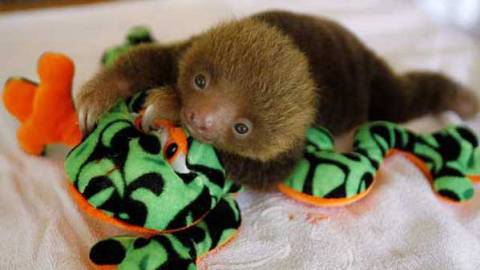Costa Rica News – More than in any other rainforest, Costa Rica’s mother sloths abandon their babies. A special sanctuary exists to take care of the babies found abandoned and even some wounded adult sloths. Why are there so many cases of abandoned and wounded sloths here?
One theory is that there are genetic mutations from pesticides consumed. There are also theories related to deforestation. The sloths are found on the rainforest floor by employees of government agencies or visitors and brought to this safe haven. To date, 130 have been released back into the wild.
The center was made by an Alaskan native and her Costa Rican husband. They opened a hotel and one day a local brought a baby sloth to their door. They researched factors like diet, habitat, and behavior, and learned how to care for him. They also observed him carefully, noticing the discoloration of the teeth from eating Cecropia leaves.
Claire Trimer is the supervisor of the nursery at Aviarios Sloth Sanctuary. She weighs and feeds the babies daily. One baby sloth is named Linus. Linus was found abandoned by his mother, possibly due to his deformed mouth. The animals here each have their own spacious cage full of blankets and stuffed toys. The sanctuary has plenty of land, 300 acres of protected land. The funding for the project comes from visitors to the sanctuary or the attached Sloth Hotel.
These lazy animals are actually quite interesting. The two-toed and three-toed sloths are different in many ways, so much so that they really shouldn’t share the name sloth. The two-toed one is nocturnal whereas those with three toes can be seen during the day. They are also different from other mammals. They show no signs of pregnancy, not even a little bump. They are the slowest mammal, digesting only one leaf per month!
Without their mother’s training the babies will not know which foliage is poisonous. They also will not learn to move extra slow to avoid being spotted by predators. For these reasons some babies will remain in captivity their whole lives. Adults are released unless they have a serious injury that would prevent their safe release.
They would like to have room to care for more sloths by getting around the government’s red tape and finding suitable homes such as in zoos for those who must remain in captivity.

